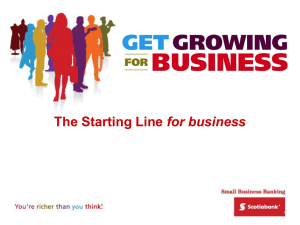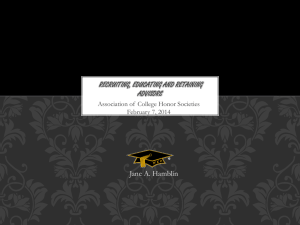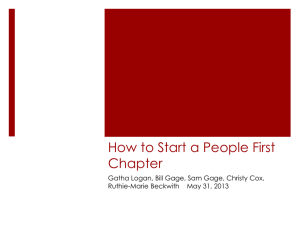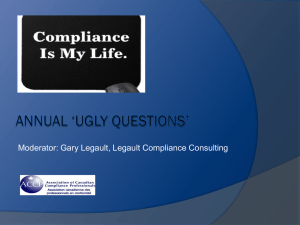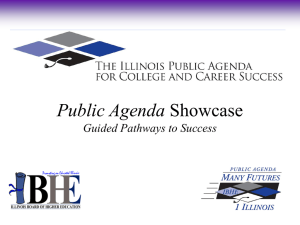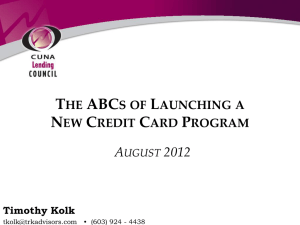Structured Schedules - Complete College America
advertisement
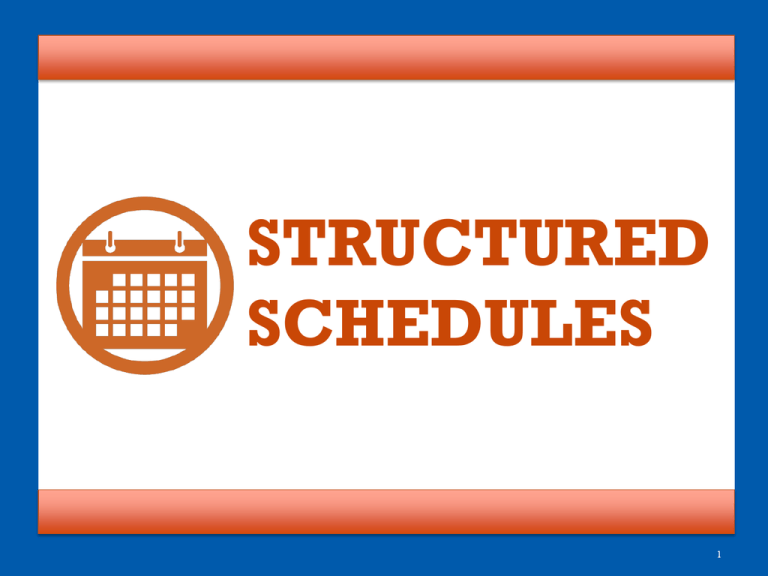
STRUCTURED SCHEDULES 1 Where there is structure, there are significant results. TENNESSEE COLLEGES OF APPLIED TECHNOLOGY 75% avg. on-time graduate rate TENNESSEE COMMUNITY COLLEGES 14% avg. on-time graduate rate 2 Where there is structure, there are significant results. ASAP PROGRAM CITY UNIVERSITY OF NEW YORK 55% 3-year graduation rate for associate degrees • Doubled graduation rates using structured scheduling, whole programs • 3X higher graduation rate than national avg. for urban community colleges 3 Where there is structure, there are significant results. IVY INSTITUTE OF TECHNOLOGY PROGRAM IVY TECH COMMUNITY COLLEGE SYSTEM • Structured career certificate programs in welding, machine tool, automotive, HVAC, mechatronics, and office technology. First Cohort: 85% completion New Cohorts: 90% retention 4 Where there is structure, there are significant results. PROMISING PROGRAM: STRUCTURED LEARNING COMMUNITIES TENNESSEE COMMUNITY COLLEGES As of Fall 2012: 63 Structured Learning Communities statewide 2,738 students enrolled 3 certificates in General Ed for transfer students, career programs in Education and Business 75% graduation/enrollment rate The New Majority 6 DISCONNECT What Students Want for Success vs. What We Provide 7 Indiana’s Path to Success: Perspectives on Guided Pathways to Degree Completion Indiana’s Path to Success: Perspectives on Guided Pathways to Degree Completion September 19, 2013 PUBLIC AGENDA • Nonpartisan, nonprofit research and stakeholder organization that fosters progress on complex and divisive issues • Wide experience in higher education policy and practice • Focus on improving the quality and accelerating the pace of problem solving PROJECT GOALS • Document advisor and student perceptions of obstacles to smooth pathways and timely completion • Probe advisor and student reactions to guided pathways policy proposals aimed at acceleration and preventing the accumulation of wasted credits RESEARCH CONDUCTED • 11 focus groups with: • Broader context: 50 focus group conversations with 333 students in IN about barriers and enablers to transfer • professional advisors • faculty advisors • current students • non-completers CONTEXT: THE PARADOX OF CHOICE • Common belief: More choice = More freedom • Reality: Too many choices creates anxiety, leads to irrational decision-making processes. Implications for Higher Education: • Vast array of program and course choices • contribute to student confusion, poor decisions and swirl. Need for a more sensible “choice architecture” that empowers students to make good decisions. Overview of What We Heard • Students initially choose programs for which they are not suited, • Students make inappropriate course selections once in programs, slowing progress and undermining persistence • Advisors are overwhelmed, have difficulty providing effective guidance • Advisors report frequent information changes, tensions between faculty and professional advisors that cause mistakes in advising • Transfer students face particular challenges REALITY: ADVISORS ARE OVERWHELMED. What is the average ratio of advisors to students at public community colleges? Advisors are overwhelmed. “The ratio of student to advisor could be as high as 1100 to one. We try to give 30-minute appointments, but when it gets busy it could be 10 minutes.” Guided Pathways to Success Perspectives from Indiana College Students and Advisors 15 Advisors are overwhelmed. “I think we’re in the mode of let’s get them out the door as quick as we can. The conversations go like this: Here’s what you need to take. You want this program? OK, boom, boom, boom. Now, is that going to interfere with your life? Oh, don’t worry. It’s okay.” Guided Pathways to Success Perspectives from Indiana College Students and Advisors 16 Students miss out on clear guidance. “I think one of our biggest problems with advisors, though, is that they are swamped with students. They have so many students to get through. …Go to this office, take a number, and get a random person, whoever was there that day at that time.” Guided Pathways to Success Perspectives from Indiana College Students and Advisors 17 Overview of Obstacles • Students make poor selection of initial program of study • Students make poor selection of courses once in program • Advisors navigate shifting requirements, poor channels of communication, large caseloads • Transfer students face especially daunting challenges OBSTACLE: POOR SELECTION OF INITIAL PROGRAM OF STUDY • Students lack goal clarity, are faced with a dizzying array of choices, have few resources to help find a good fit program • Advisors say caseloads are too large to give students adequate support, end up scheduling rather than advising REALITY: SOME ADVISING PRACTICES CAN MAKE MATTERS WORSE What comes to mind when you consider the phrase “August train wreck”? Some advising practices can make matters worse. “In August, all bets are off. They throw the (admissions) rules out the window. They say, ‘Just register them. We need those numbers. Get them in here, get them in here, get them in here.’ We’re just registering…doing exactly what we were told.” Guided Pathways to Success Perspectives from Indiana College Students and Advisors 21 OBSTACLE: POOR SELECTION OF COURSES ONCE IN PROGRAM • Students select courses that are not part of program or fail to take prereqs at appropriate time • Complex life situations make it hard for students to schedule courses when they are offered • Students self-advise based on inadequate or outdated information OBSTACLE: TRANSFER STUDENTS FACE DAUNTING CHALLENGES • Fragmented, incomplete, inaccurate or hardto-access information on transfer • Advisors and students have difficulty determining which courses will transfer • Courses that do transfer often counted only as electives REALITY: STUDENTS LIVE COMPLICATED LIVES. What percentage of students at 2-year schools work 20 or more hours each week? Students live complicated lives. “It is insane. I mean – they’re dropping like flies, and it is like we don’t have anything on campus to anchor them. We don’t have people who are trained counselors, whose job is to help them through these things. They’re trying to juggle 18 balls in the air, and they’re trying to take 18 credit hours. They’re trying to work full-time, like, four jobs. They’re just stringing together tragedies and it’s difficult.” Guided Pathways to Success Perspectives from Indiana College Students and Advisors 25 GUIDED PATHWAY PROPOSALS REVIEWED • Proactive advising and informed choice • Degree maps and guaranteed courses • Block schedules and structured cohorts PROPOSAL: PROACTIVE ADVISING AND INFORMED CHOICE • • • Enthusiastic support for better advising technology Hope that this will supplement and focus existing advising, rather than replace it Interest in developing advising technology that also has accurate information on transfer articulation Proactive Advising “This would be wonderful. What is described here would be amazing. We can do some of this now but not in an automatic way. But right now we do that by pulling out their folder and going through every semester.” Guided Pathways to Success Perspectives from Indiana College Students and Advisors 28 PROPOSAL: DEGREE MAPS AND GUARANTEED COURSES • • • Supported by many students and advisors Concerns from small departments about ability to guarantee courses Worries from two-year programs that students do not have time to explore Degree Maps and Guaranteed Courses “I think if they did something like take every degree there is and put them under, like, six fields, like a big umbrella. Then you can pick out which individual degree, if you know what you want. Then have something like a 101 class for each particular degree just to see, so students can test the waters to see if they even like it, and that would be their very first semester. That way they’re not wasting Guided Pathways to Success time.” Perspectives from Indiana College Students and Advisors 30 REALITY: STUDENTS LIVE COMPLICATED LIVES. True or False: Students who have difficulty balancing work and school want more flexibility in their schedules. Students want structure… “That (block scheduling) would be fabulous – if you knew you could schedule your courses every semester at the same time, wouldn’t that be a dream come true?” Guided Pathways to Success Perspectives from Indiana College Students and Advisors 32 Students want structure… “I actually like that approach because I’ve had the days where I go to class for an hour, and then I have two hours off. Well, I really don’t want to drive home just to drive all the way back. Yes, it might suck to be in class for four hours straight, but I could go into a job and say, “I go Monday through Friday from eight to noon but I can come in at one thirty or two o’clock and work with you guys.” I think employers would appreciate that more because I’ve actually missed out on a couple of jobs because of my school schedule.” Guided Pathways to Success Perspectives from Indiana College Students and Advisors 33 Advisors offer flexibility. “A block schedule for a nontraditional student doesn’t work. You work. You have a family. They’re like, “I can’t take this course because it’s offered when I’m supposed to be working. If I don’t work, I can’t pay for school. If I can’t pay for school, then I can’t get a better job.” Guided Pathways to Success Perspectives from Indiana College Students and Advisors 34 PROPOSAL: BLOCK SCHEDULES AND STRUCTURED COHORTS • • • • Enthusiastically supported by many students (especially non-completers and those with complex lives) Advisors concerned about negative impact on students with complex lives. Concerns about implementation challenges Concerns that this approach undercuts students learning self-management RECOMMENDATIONS FOR ENGAGING STAKEHOLDERS • • • • Communicate clearly about relationship between pathways efforts and other initiatives and priorities Take concerns seriously and address them directly Create opportunities for institutional stakeholders to deliberate about policy proposals and implementation obstacles Include institutional stakeholders as partners in planning and implementation process INDIANA’S PATH TO SUCCESS Thank you! For more information: Alison Kadlec, Ph.D. akadlec@publicagenda.org www.publicagenda.org 38

